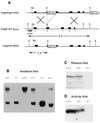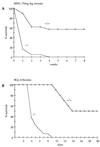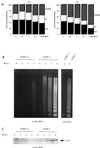Requirement of poly(ADP-ribose) polymerase in recovery from DNA damage in mice and in cells
- PMID: 9207086
- PMCID: PMC23816
- DOI: 10.1073/pnas.94.14.7303
Requirement of poly(ADP-ribose) polymerase in recovery from DNA damage in mice and in cells
Abstract
Poly(ADP-ribose) polymerase [PARP; NAD+ ADP-ribosyltransferase; NAD+: poly(adenosine-diphosphate-D-ribosyl)-acceptor ADP-D-ribosyltransferase, EC 2.4.2.30] is a zinc-finger DNA-binding protein that detects specifically DNA strand breaks generated by genotoxic agents. To determine its biological function, we have inactivated both alleles by gene targeting in mice. Treatment of PARP-/- mice either by the alkylating agent N-methyl-N-nitrosourea (MNU) or by gamma-irradiation revealed an extreme sensitivity and a high genomic instability to both agents. Following whole body gamma-irradiation (8 Gy) mutant mice died rapidly from acute radiation toxicity to the small intestine. Mice-derived PARP-/- cells displayed a high sensitivity to MNU exposure: a G2/M arrest in mouse embryonic fibroblasts and a rapid apoptotic response and a p53 accumulation were observed in splenocytes. Altogether these results demonstrate that PARP is a survival factor playing an essential and positive role during DNA damage recovery.
Figures





References
-
- Althaus F R, Richter C. Mol Biol Biochem Biophys. 1987;37:1–125. - PubMed
-
- Ménissier de Murcia J, de Murcia G. Trends Biochem. 1994;19:172–176. - PubMed
-
- Ménissier de Murcia J, Molinete M, Gradwohl G, Simonin F, de Murcia G. J Mol Biol. 1989;210:229–233. - PubMed
-
- Simonin F, Ménissier de Murcia J, Poch O, Muller S, Gradwohl G, Molinete M, Penning C, Keith G, Murcia G. J Biol Chem. 1990;265:19249–19256. - PubMed
Publication types
MeSH terms
Substances
LinkOut - more resources
Full Text Sources
Other Literature Sources
Molecular Biology Databases
Research Materials
Miscellaneous

